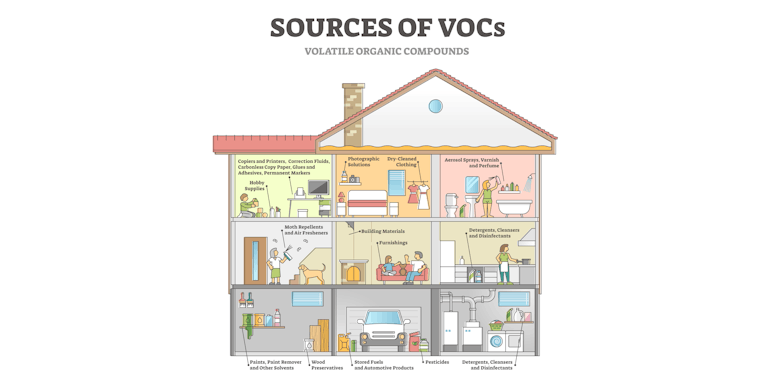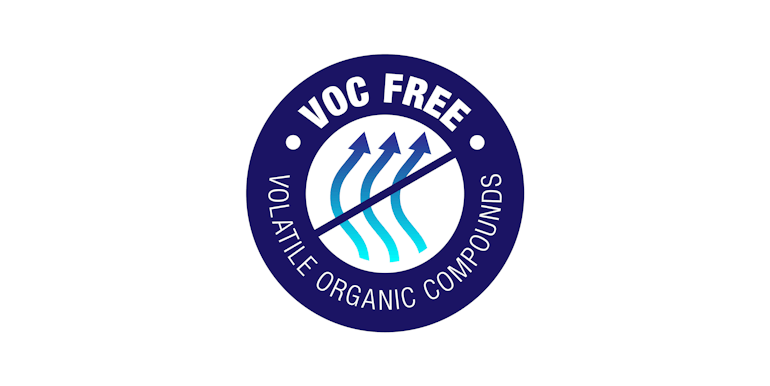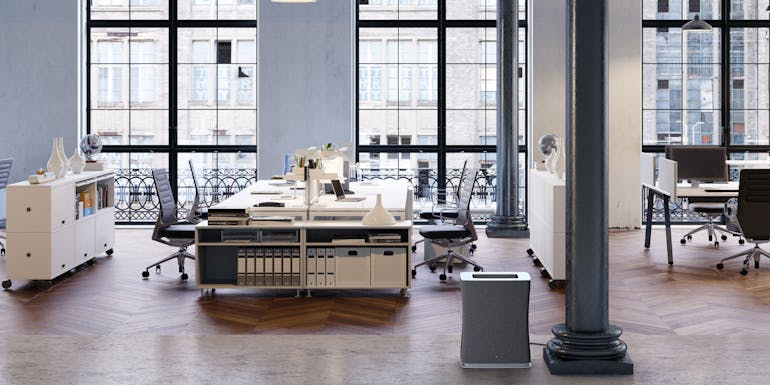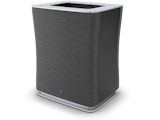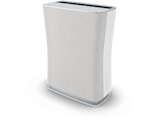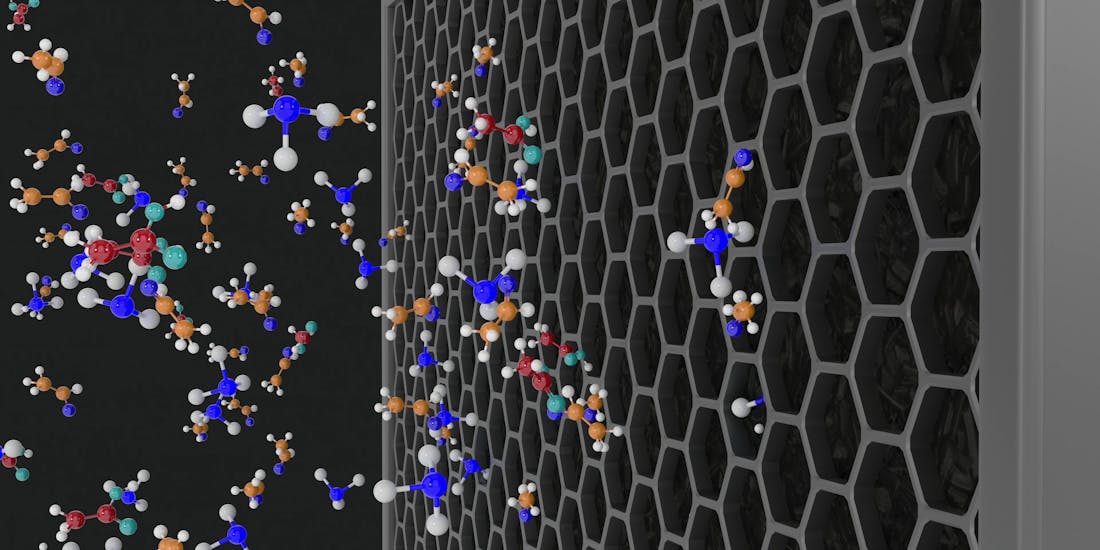
Nadine Walder, 22 May 2023
Virus protection
Pollutants: combatting VOCs in the office with an air purifier
Wir verbringen ungefähr 90 % unserer gesamten Zeit in Innenräumen, ein Grossteil davon am Arbeitsplatz. Für unser Wohlbefinden ist deshalb eine gute Luftqualität auch am Arbeitsplatz sehr wichtig. Büroräume weisen allerdings häufig hohe Schadstoffkonzentrationen auf, die aus verschiedenen Quellen stammen können. Flüchtige organische Verbindungen (VOCs) sind ein Beispiel dafür. In zu hoher Konzentration können sie unser Wohlbefinden beeinträchtigen und die Gesundheit schädigen.
Read on to find out:
- What are volatile organic compounds (VOCs)?
- How dangerous are VOCs?
- VOC values and the measurement of pollutants in the workplace
- Tips for keeping the concentration of VOCs in the office as low as possible
- An air purifier in the office can reduce VOCs efficiently
What are volatile organic compounds (VOCs)?
VOCs (volatile organic compounds) are found in many products such as paints, varnishes, adhesives and cleaning products, to name just a few. These compounds evaporate into the air at room temperature. VOCs can be found in gaseous form in the air and have a variety of sources, both natural and human. Examples of well-known VOCs include formaldehyde, benzene, toluene and xylene.
Natural sources of VOCs include biological processes in plants such as the emission of essential oils that serve to repel pests or produce the scent of flowers and fruit, for example. Human activities are also a significant source of VOCs. Industrial processes such as the production of chemicals, paints, varnishes, solvents, cleaning products and propellants contribute towards the release of VOCs. The use of household products such as paints, cleaning products, cosmetics such as hairspray, perfumes and even furniture and carpets can also contribute to the pollution of indoor air by VOCs.
How dangerous are VOCs?
The impact of VOCs on health will depend on the type of VOC, the concentration, the period of exposure and individual sensitivity. VOCs can cause a wide range of symptoms, some of which can have short-term effects such as irritation of the eyes, nose and throat, headaches, nausea and dizziness. Other VOCs such as benzene and formaldehyde are known for their potentially carcinogenic properties. Long-term exposure to these substances can cause damage to organs such as the liver, kidneys and nervous system.
VOCs can affect the quality of the indoor air and contribute to so-called “sick building syndrome”. Symptoms of this syndrome can include headaches, fatigue, difficulty concentrating, nausea and dizziness. Sick building syndrome has mainly been studied in workplaces but can also occur in homes.
VOC values and the measurement of pollutants in the workplace
The concentration of VOCs in the air is often expressed as total volatile organic compounds (TVOC). The TVOC value is a measurement of the total concentration of all volatile organic compounds in the air. It covers all types of VOCs, including those that are harmful to health and those that are less harmful.
As a rule, the TVOC value is measured in parts per million (ppm) or milligrams per cubic metre (mg/m3). The TVOC concentration is related to the indoor air as follows:
- Values lower than 0.3 mg/m3 are regarded as excellent and there are no concerns.
- Values between 0.3 and 1 mg/m3 are regarded as good and there are no relevant concerns. Ventilation is recommended.
- Values between 1 and 3 mg/m3 are regarded as mediocre and there are a few concerns. Increased ventilation and the identification of sources are recommended.
- Values between 3 and 10 mg/m3 are regarded as poor and there are major concerns. Increased ventilation is necessary and sources must be identified.
- Values between 10 and 25 are regarded as harmful to health and the situation is unacceptable. It is recommended that rooms should only be used if unavoidable and for sources to be identified.
It is important to note that the TVOC value measures all VOCs in the air and does not specifically focus on one particular compound.
There are various methods for measuring the TVOC value in the air, the simplest being the use of handheld VOC measurement devices. These devices measure the total concentration of all volatile compounds in the air and give the TVOC value in ppm or mg/m3. Handheld VOC measurement devices are easy to use and relatively cheap, making them suitable for home use or for small businesses.
For larger companies or industrial applications, there are also professional VOC measurement devices which allow more precise measurement and monitoring of the air quality. These devices can also identify and measure specific VOCs so that a targeted solution to air quality problems can be found.
Regardless of the method of measurement, it is important to monitor the indoor air quality regularly and take suitable measures to reduce the concentration of VOCs in order to ensure a healthy work environment.
Tips for keeping the concentration of VOCs in the office as low as possible
There are a number of efficient tips for reducing or keeping the concentration of VOCs in the office as low as possible They include:
- Ventilation: Ensure that ventilation is carried out regularly in the office to improve air quality. Open windows to let fresh air in and VOCs out.
- Plants: Bring some air-purifying plants into the office: certain plants such as peace lilies, snake plants or spider plants can absorb VOCs and improve air quality.
- Environmentally-friendly cleaning products: Make sure that you use environmentally-friendly cleaning products in the office. A lot of conventional cleaning products contain VOCs which are released and can affect air quality.
- Avoiding solvents: Avoid using solvents or strong-smelling products in the office as they often contain VOCs. Look for alternatives or only use them in well-ventilated areas.
- Reduction of printer and photocopier emissions: Devices such as printers and photocopiers can release VOCs into the air. Make sure that these devices are maintained regularly and set up in a well-ventilated area.
- Storage of chemicals: If you need to store chemicals in the office, make sure that they are securely sealed and kept away from work areas in order to prevent the spread of VOCs.
- Office supplies: When purchasing office supplies such as paints, adhesives and furniture, look for products that are labelled as low-emission or VOC-free. Find out about alternatives.
- Raising of awareness and training: Raise employee awareness of VOCs and their effects on health. Training can help raise awareness of the air quality in the office and promote positive changes.
Regardless of these tips, offices where there is a medium to high concentration of VOCs should also have an air purifier in order to reduce VOCs in the office.
An air purifier in the office can reduce VOCs efficiently
Air purifiers can be an effective way of reducing the concentration of VOCs in the air. How it works:
- Filtration system: An air purifier is equipped with a special filter system which normally consists of a preliminary filter and a combination of an activated carbon filter and a HEPA filter or electrostatic filter. The preliminary filter captures larger particles such as dust and hair while the activated carbon filter adsorbs VOCs and the HEPA or electrostatic filter removes the smallest particles such as allergens and fine dust.
- Adsorption of VOCs: The activated carbon filter is particularly effective at removing VOCs. Activated carbon consists of porous material with a large surface on which VOC molecules can be adsorbed. Via this process, VOCs are removed from the air and trapped in the activated carbon.
- Circulation of the purified air: The air purifier draws in the indoor air and directs it through the filter system. VOCs are removed from the air in the process. The purified air is then emitted back into the room. This continuous process ensures that the concentration of VOCs in the office will be gradually reduced.
When using an air purifier, it is advisable to choose a suitable filter system and to change the filters regularly in accordance with the manufacturer’s instructions. You should also maintain and clean the device regularly.
Stadler Form air purifiers meet the requirements that an air purifier has to fulfill in order to reduce the concentration of VOCs. However, they are not just efficient, they also look good and so will fit in well in any office.
If you have questions related to indoor room climate, please get in touch with us. Or subscribe to our newsletter to regularly get informed about current topics regarding indoor climate, experience reports or Stadler Form insights.

